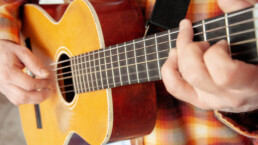Organizing Your Guitar Practice Time
I hear frequently from students that they don’t know what to focus on, or how to organize their guitar practice time.
There’s so much material out there, and so many things to be interested in. How can you possibly find time to do it all? You can’t, of course. If you’re like most people, you carve out time to play guitar wherever your life allows it. So wondering whether you’re spending it productively is only natural. One good way to do this is to divide your guitar practice repertoire into categories:
-
new material you’re learning
-
songs in progress you’re working to improve
-
songs you can comfortably play
One powerful approach is to establish a “practice pipeline”: a method and process to move a song from the first stage to the third. When time is limited, this is a great way to make sure you’re moving things forward. We do this by setting specific goals, depending on where in the process you are.
- Learning new material, the goal is to get to know the notes.
- Polishing material, the goal is to identify and work out the trouble spots.
- Performing material, the goal is to maintain a comfortable flow through the song.
Even if you only had time to work on one song in a given practice session, you can make a measurable improvement in one of the three areas. Learn a new lick, or take a closer look at why you’re finding a particular part so challenging. Put your problem-solving skills to work, or spend fifteen minutes with a jam track. In each case you’re focusing on one of our three primary areas: absorbing, polishing, and flowing.
This approach is even more powerful when you follow a thread through the guitar practice routine. Things like technical exercises and theory can connect to the songs in your pipeline. For example, you might practice a finger pattern in preparation for learning a more complex lick. Or you might analyze the chord structure of a song to help reinforce your ear and memory. It’s easier to remember an unfolding story than a disconnected series of events.
Once you’ve categorized your material, it’s easier to decide where to focus.
Don’t worry about getting to everything if time is limited. The ongoing process is the most important part: returning again and again to your guitar with a specific intention.
Remember also that repetition doesn’t automatically equal improvement. If you work with a teacher or coach, you would expect feedback on your execution and form. So be your own coach. Be aware of more than just whether or not you nailed the note. Often, the issue is not in the landing but in the movement to get there. Never practice technique blindly, whether it’s an exercise or a lick from a song. Your goal is continual improvement, and it wont happen without looking at the “how” as much as the “what”.
If you miss something repeatedly, there’s a reason, and it might not be that it’s beyond your ability.
Even if that reason is limited technique, taking that closer look will reveal how to surpass that limitation.
Performance or flow practice is also hugely important. If you aren’t playing actual music, it’s difficult to really grow. “Actual music” is also not necessarily difficult. If you aren’t having fun at some point doing something simple, you’re leaving out the best part! Besides, there’s more to playing a song well than just nailing the chords. When I was learning to play, I might think a repetitive three-chord song was boring. I didn’t understand then about dynamics, or the concept of shaping a performance. The places your fingers need to land are just the beginning steps. Learn about pocket and groove and tone and energy. Be able to play your parts without staring at your fingers, or locking your whole body in concentration. When you can flow and move as you play, you’ll perform with a lot more confidence. You’ll also enjoy the experience that much more.
Above all, focus on the process.
If you accomplish something small every time you pick up your guitar, you will see progress. Concentrating on a small number of things at a time keeps you focused. Rotating those things keeps you engaged. Doing it again and again intentionally keeps you growing.
Interested in more guitar lessons and courses? Check out JamPlay.com. JamPlay has over 450 guitar courses from 120+ instructors, and online guitar lessons tailored to every skill level, music genre, and playing style. Click here to learn more.
Dave Isaacs has established himself as a guitar teacher extraordinaire, having built a strong set of educational curriculums for beginner, intermediate, and advanced guitar players alike. Dave shares his expertise largely through video platforms, but also through his thoughtful writing. You can take guitar lessons from Dave Isaacs via his comprehensive video guitar courses on JamPlay.com.
Share this
Become a JamPlay member for unlimited access to 7000+ guitar lessons and 120+ artists and instructors. View membership plans ›




